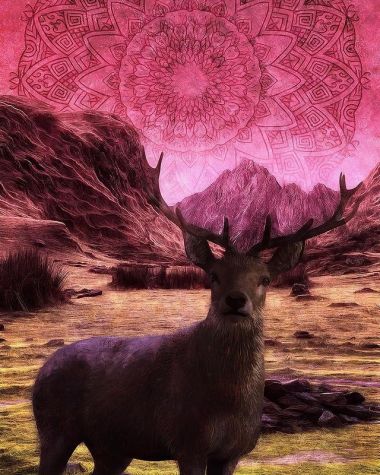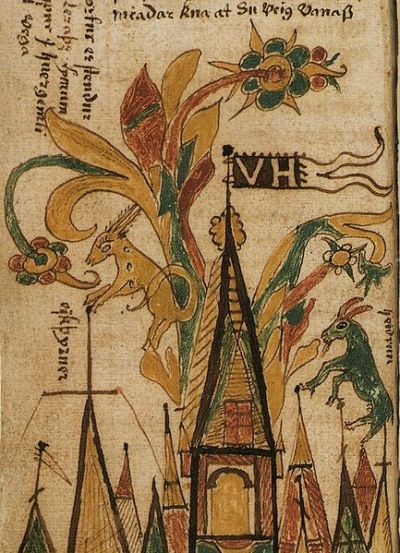In the stories of Norse mythology, there stands a creature as enigmatic as the misty realms it hails from. I’m talking about Eikthyrnir, the stag that perches atop Valhalla, whose story is as intriguing as it is ancient. This majestic being isn’t just another character in the Norse pantheon; it’s a symbol of life.
Standing on top of the roof of Valhalla, along with the goat Heidrun, Eikthyrnir fed on the leaves of Yggdrasil. He also provided all the water that filled the well Hvergelmir, source of all rivers in the nine realms.
Key Facts
| Origin | Norse Mythology |
| Role | Source of Rivers in Norse Cosmology |
| Habitat | Valhalla |
| Other Names | Eikþyrnir |
| Associated with | Valhalla, the Tree Læraðr |
Name and Etymology
The name Eikthyrnir (Old Norse: Eikþyrnir) is a compound of two elements. Firstly “eik,” meaning “oak,” and seconbdly, “þyrnir,” which translates to “thorns” or “antlers.” Painting an image of a stag with antlers as robust and sprawling as the branches of an oak tree. The anglicized form, Eikthyrnir, retains the original meaning while adapting to the phonetic comforts of the English language. In modern Norwegian, we say Eikthyrne, which is a perfect example of how similar Old Norse and Norwegian sometimes are.
Eikthyrnir is not merely a name but a title that conveys the creature’s essence and the awe it inspires. Moreover bridging the ancient world with the present through the power of myth and language.
Eikthyrnir’s Role and Significance
In the grand scheme of Norse cosmology, Eikthyrnir holds a place of honor. Perched atop Valhalla, the hall of the slain warriors, he eats from the leaves of Yggdrasil. He is such a colossal stag that the water that is (for some reason) flowing from its antlers flows into the well Hvergelmir. From there, the water runs on, feeding into all the rivers of the nine realms, sustaining life. It also serves as a testament to the interconnectedness of all life in the Norse universe.
The reason for Eikthyrnir’s existence is intertwined with the very essence of Norse beliefs. It’s a physical embodiment of life’s sustenance, a guardian of vitality that stands as a reminder of the natural order. The stag’s presence in Valhalla also signifies the connection between the fallen warriors and the eternal life forces. It is a cycle that repeats itself, just like they believed in an afterlife.
In a more natural way to look at it, he might have been the explanation for both rain and dew. However, dew was also attributed to Hrimfaxi, the horse that draws Nótt’s chariot across the sky.
Depiction And Characteristics

Eikthyrnir is depicted as a stag of remarkable beauty and strength, with antlers that reach towards the heavens. I have heard that the antlers, in a mist of dew, might have been associated with clouds in the sky. It fits with the dripping dew that falls to the earth to become the rivers of the world. This image is not merely a physical description; it’s a symbol of the life-giving energies that flow through the Norse cosmos. The stag’s association with water, a vital element for life, underscores its importance as a life-sustainer.
Myths about Eikthyrnir
Eikthyrnir has a notable mentione found in the Prose Edda. There he is described as a stag that stands atop Valhalla. From his antlers, a clear dew drips down into the well Hvergelmir. It is not just any well, but the wellspring that is the source of all the rivers in Norse cosmology. This connection between Eikthyrnir and the life-giving waters of the world highlights the stag’s importance in the maintenance of life.

The imagery of Eikthyrnir, with dew falling from its antlers into Hvergelmir, is a potent symbol within Norse mythology. It represents the endless cycle of life and the sustenance provided by the natural world. The dew from Eikthyrnir’s antlers that feeds into the rivers is a metaphor for the life-giving forces of nature. Furthemore emphasizing the interconnectedness of all things and the Norse respect for the environment.
Eikthyrne in the Prose Edda
The stag is introduced in chapter 40 in the Gylfaginning part of the Prose Edda. It follows a description of the goat Heidrun.
“Then said Har: Still more remarkable is the hart Eikthyrner, which stands over Valhalla and bites the branches of the same tree. From his horns fall so many drops down into Hvergelmer, that thence flow the rivers that are called Sid, Vid, Sekin, Ekin, Svol, Gunthro, Fjorm, Fimbulthul, Gipul, Gopul, Gomul and Geirvimul, all of which fall about the abodes of the Aesir. The following are also named: Thyn, Vin, Thol, Bol, Grad, Gunthrain, Nyt, Not, Non, Hron, Vina, Vegsvin, Thjodnuma.”
Eikthyrne in the Poetic Edda
Snorri didn’t come up with much himself. Instead, he sourced most of his knowledge from poems from the collection we know today as the Poetic Edda. The mention above, found in the Gylfaginning, likely comes from the poem Grímnismál, stanzas 26 to 28.
26. The stag Eikthyrnir | stands by Odin’s hall,
- The stag Eikthyrnir | stands by Odin’s hall,
Feeding on the branches of Læradr;
From his horns | drips into Hvergelmir
Flowing into all rivers.
- Sid and Vid, | Sækin and Eikin,
Svol and Gunnthro,
Fiorm and Fimbulthul,
Rin and Rennandi,
Gipul and Gopul,
Gomul and Geirvimul,
They flow through the realms of gods;,
Thyn and Vin, | Tholl, and Holl,
Grad and Gunnthorin.
- Vin is one named, | Vegsvin another,
A third is Thiodnuma,
Nyt and Not, | Nonn and Hronn,
Slid and Hrid, | Sylg and Ylg,
Vid and Van, | Vond and Strond,
Gjoll and Leipt, | they flow close to men,
And fall down to Hel after.
Frequently Asked Questions
Dew drips from the antlers of Eikthyrnir, flowing into the well Hvergelmir which feeds into all the rivers.
The mystical stag Eikthyrnir resides in Valhalla, among the halls of the slain warriors.
Yes, the goat Heidrun is also standing on top of Valhalla, eating from Yggdrasil.
Eikthyrnir is typically depicted as a majestic stag with expansive antlers.
Featured Image Credit: Unknown author, Public domain, via Wikimedia Commons
